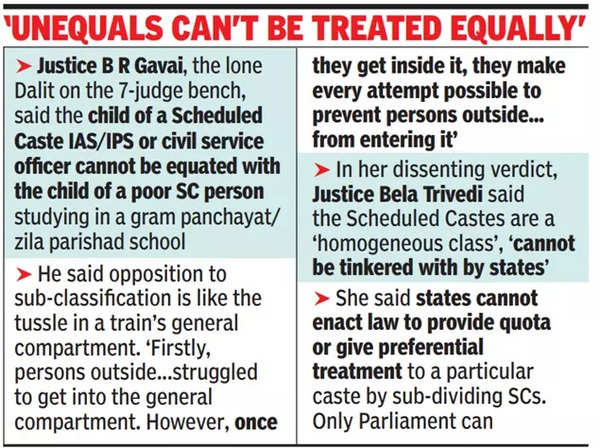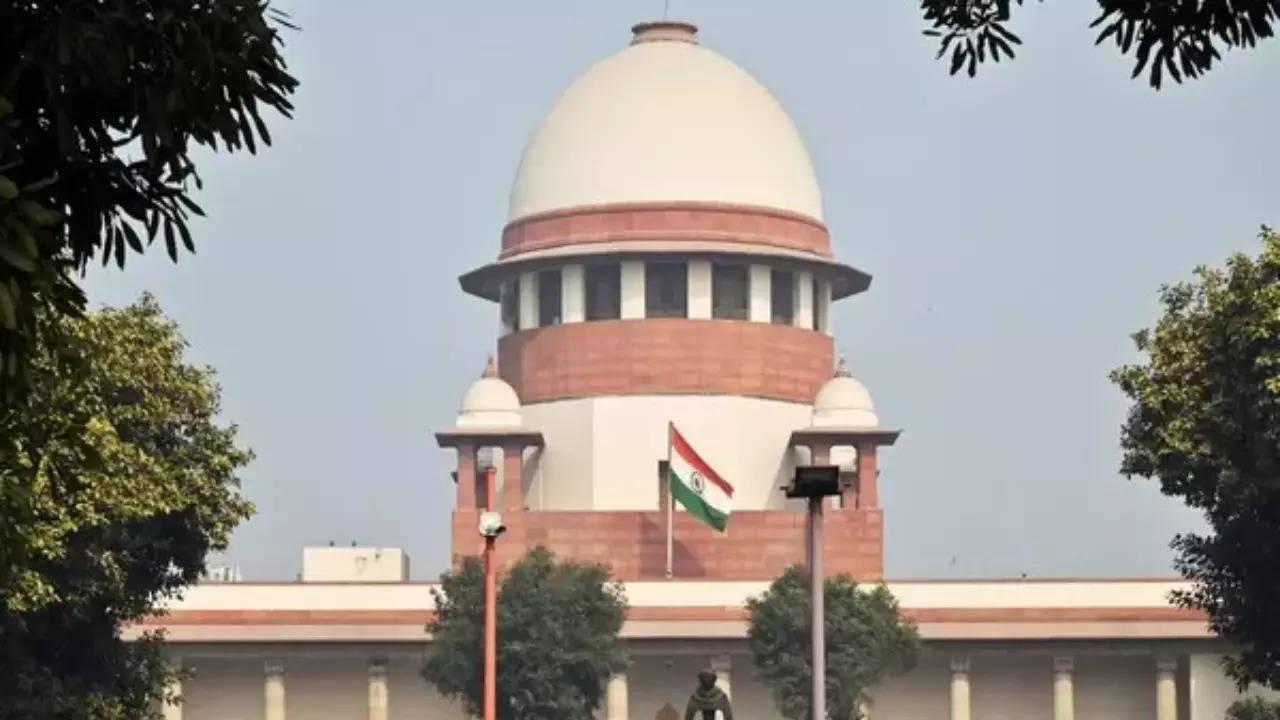Limit reservation to first generation that avails it & benefits from it: Justice Mithal
NEW DELHI: In a landmark decision, Supreme Court on Thursday permitted states to sub-categorise castes within the Scheduled Castes (SC) based on socio-economic back wardness and degree of under-representation in govt jobs to ensure that the larger pie of 15% SC quota goes to backwards among them. It also asked govts to devise suitable criteria to bar the ‘creamy layer’ among SCs and STs from availing reservation.
By this 6:1 majority ruling, a bench of Chief Justice D Y Chandrachud and Justices B R Gavai, Vikram Nath, Bela M Trivedi, Pankaj Mit hal, Manoj Misra and S C Sharma overruled the 2004 judgment of a five-judge bench in EV Chinnaiah case which had said SCs were a homogeneous group and could not be sub-categorised. Justice Trivedi dissented and said the Chinnaiah judgment was constitutionally valid.
To minimise politics and executive play over extension of the ‘quota within quota’ concept to Scheduled Castes, the court clarified that sub-classification of castes within SCs cannot be based on govt’s whims or political considerations.
It firmly said sub-classification of the most backward among the SC community must be based on empirical data, both quantifiable and demonstrable, regarding their backwardness.

Limit reservation to first generation that avails it & benefits from it: Justice Mithal
The logic behind the court’s suggestion for keeping the ‘creamy layer’ out is that children of civil servants and others from among the SCs who have moved up the socio-economic ladder and received good education are not deserving of quotas. At present, creamy layer exclusion policy is applicable only to other backward classes (OBCs).
The CJI authored a 140-page judgment for himself and Justice Misra. Justices Nath, Mithal and Sharma, through separate opinions, agreed with the opinions of the CJI and Justice Gavai. Both the CJI and Justice Gavai agreed with each other, thus making six of the seven judges concur on the constitutional permissibility of sub-classification of SCs.
It was Justice Gavai, the lone Dalit judge on the bench, who held that those among SC/ST communities who have got top positions in civil services and risen high in socio-economic strata must get excluded from the reservation scheme for scheduled castes, who were socially discriminated for centuries.
Justice Mithal took the creamy layer exclusion principle to a different level. “Reservation, if any, has to be limited only for the first generation or one generation and if any generation in the family has taken advantage of reservation and has achieved higher status, the benefit of reservation would not be logically available to the second generation,” he said.
In his 281-page opinion, Justice Gavai said, “The state must evolve a policy for identifying the creamy layer even from the scheduled castes and scheduled tribes so as to exclude them from the benefit of affirmative action. In my view, only this and this alone can achieve the real equality as enshrined under the Constitution.”
Cautioning states that subcategorisation of SCs ought to be based on empirical data, CJI Chandrachud said, “Where the action is challenged (before the HC or the SC), the state will have to justify the basis of its action. The basis of the sub-classification and the model which has been followed will have to be justi fied on the basis of empirical data gathered by the state.”
He further said, “It cannot merely act on its whims or as a matter of political expediency. The decision of the state is amenable to judicial review… the state must provide justification and rationale for its determination. No state action can be manifestly arbitrary. It must be based on intelligible differentia which underlie the subclassification. Basis of the sub-classification must bear a reasonable nexus to the object sought to be achieved.”
Giving an example, the CJI said if a state decides to provide a different percentage of reservation to ‘dhobi’ and ‘barber’ castes, “it must prove that these two castes suffer from differing levels of social backwardness. It is not merely sufficient for the state to base the classification on the difference in the traditional occupation of the two castes”.
Justice Nath, who agreed with the CJI, said, “I am also in agreement with the opinion of Justice Gavai that ‘creamy layer’ principle is also applicable to SCs and STs and that the criteria for exclusion of creamy layer for the purpose of affirmative action could be different from the criteria as applicable to OBCs.”
Justice Sharma also agreed with the CJI and Justice Gavai.
